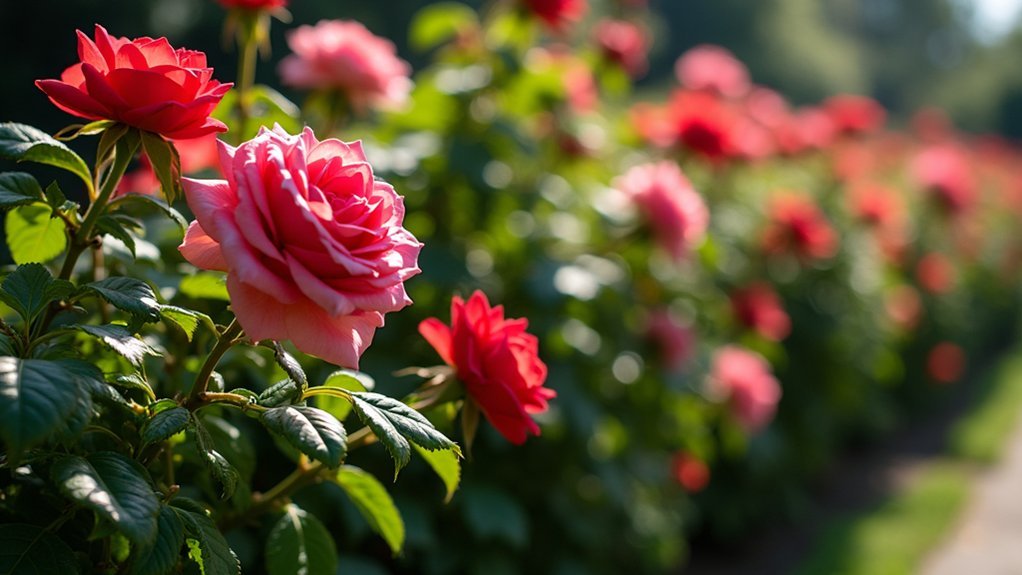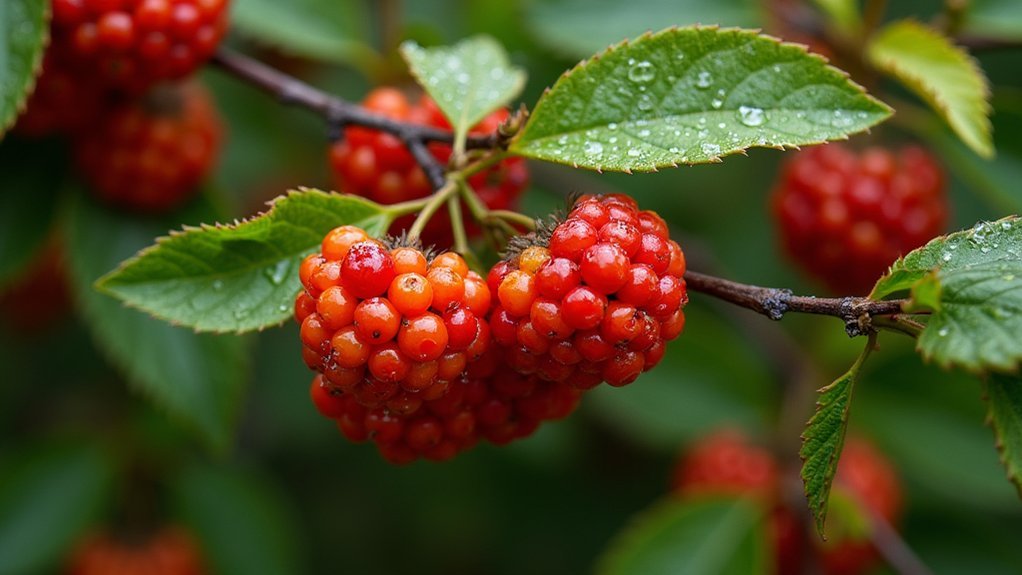For defensive, thorny privacy hedges, you’ll find three excellent options: Rose bushes offer beauty with natural security, growing up to 8 feet tall with fragrant blooms. Barberry hedges create impenetrable barriers with dense, spiny branches in various colors, reaching 2-8 feet high. Firethorn provides year-round protection with white flowers and bright berries while deterring intruders with sharp thorns. Each option combines aesthetic appeal with practical security for your property boundaries.
Rose Bushes: Elegant Security for Property Boundaries

While many homeowners focus solely on aesthetic appeal when selecting hedge plants, rose bushes offer both beauty and security in one package. Their thorny stems create a natural deterrent against intruders while providing vibrant blooms in various colors from pink to yellow.
You’ll find shrub roses particularly well-suited for hedges, growing up to 8 feet tall when planted 2-3 feet apart. Species roses offer the most impenetrable barriers, while climbing varieties can be trained over existing fences for added privacy and drama. For optimal density in your hedge, plant roses no more than 18″ apart.
Unlike purely functional barriers, rose hedges reward you with seasonal flowers and often delightful fragrance. Many modern varieties feature improved disease resistance and relatively low maintenance requirements once established.
With proper soil preparation and regular pruning, your rose hedge will provide year-round interest and protection.
Barberry Hedges: Dense and Formidable Natural Barriers
Gardeners seeking the ultimate defensive hedge need search no further than barberry shrubs. These versatile plants create impenetrable barriers with their viciously spiny branches that deter both human and animal intruders.
Nature’s barbed wire! Barberry shrubs create impenetrable defensive barriers with viciously spiny branches that repel unwanted visitors.
You’ll appreciate barberry’s moderate to fast growth rate of 1-2 feet annually, reaching mature heights of 2-8 feet depending on variety. Their dense, multi-stemmed structure maintains year-round screening while tolerating regular shearing.
Choose from various cultivars like the purple-red Atropurpurea, mottled Rose Glow, or taller Berberis darwinii for specific needs. Most varieties thrive in USDA zones 4-8 in either sun or partial shade. The compact “Crimson Pygmy” cultivar offers dwarf sizing options for smaller spaces at just 2 feet high and 3 feet across.
Once established, barberries require minimal maintenance beyond annual pruning, which actually increases thorn density for enhanced security. They’ll adapt to most soil conditions and remain drought-tolerant after establishment.
Firethorn: Year-Round Protection With Seasonal Beauty

For those seeking a defensive barrier that doesn’t sacrifice beauty, firethorn (Pyracantha) delivers impressive protection alongside striking seasonal displays. This broadleaf evergreen shrub grows 6-18 feet tall and wide, forming a dense, impenetrable barrier with sharp thorns on all branches.
You’ll enjoy firethorn’s year-round appeal: showy white flowers in spring, followed by vibrant orange-red berries that persist through winter. These berries attract birds while the thorns effectively deter deer and intruders.
Firethorn thrives in various conditions—from full sun to partial shade—and adapts to most soil types. It’s easy to maintain with regular pruning and grows at a moderate rate of 6-8 inches annually. The plant can withstand temperatures as low as minus 15°C, making it suitable for colder regions.
Hardy in zones 6-9, you can shape it into formal hedges ranging from 4-10 feet tall.
Frequently Asked Questions
Are Thorny Plants Legal in All Residential Areas?
No, they’re not legal everywhere. You’ll need to check local municipal codes, HOA rules, and right-of-way regulations before planting thorny species, as many residential areas restrict them for safety reasons.
How Can Thorny Hedges Affect Property Value?
Thorny hedges can increase your property value by 15-20% through enhanced curb appeal, better security, and privacy benefits. They’re cost-efficient compared to traditional fencing and create a premium, well-maintained impression for potential buyers.
What Precautions Should Pet Owners Take With Defensive Plants?
You should select non-toxic plants, create physical barriers between pets and thorny areas, regularly trim sharp edges, train your pets to avoid these zones, and maintain clear pet pathways through your garden.
Do Thorny Hedges Require Special Insurance Considerations?
Yes, you’ll need to contemplate liability coverage if thorny hedges cause injury to visitors. Check your homeowners policy for landscaping coverage and possibly add specialized insurance for high-value plants or additional liability protection.
Can Defensive Plants Damage Foundation or Underground Utilities?
Yes, certain defensive plants can damage your foundation or utilities if their aggressive roots spread too close. You’ll want to research root patterns and maintain adequate distance when planting near structures or underground lines.
In Summary
You’ve got excellent options for natural security with these thorny defenders. Whether you choose the classic elegance of roses, the impenetrable density of barberry, or the colorful resilience of firethorn, you’ll create boundaries that deter unwanted visitors while enhancing your landscape. They’re nature’s perfect combination of beauty and protection—living security systems that serve you year after year while adding character to your property.





Leave a Reply